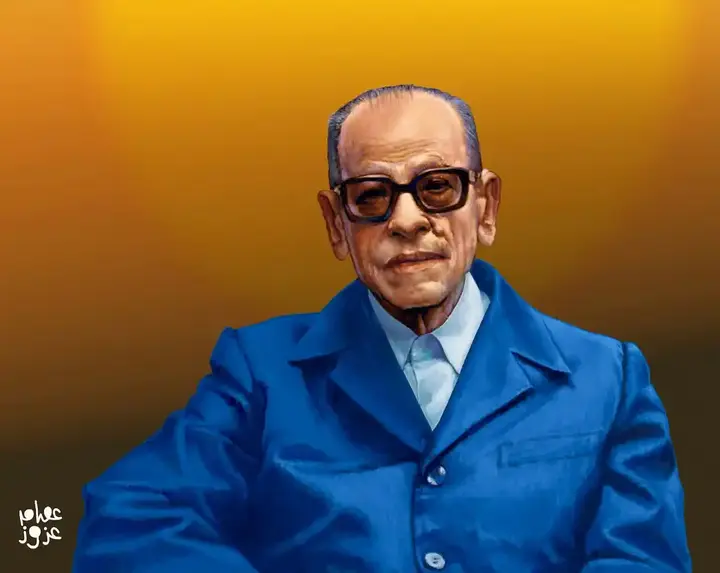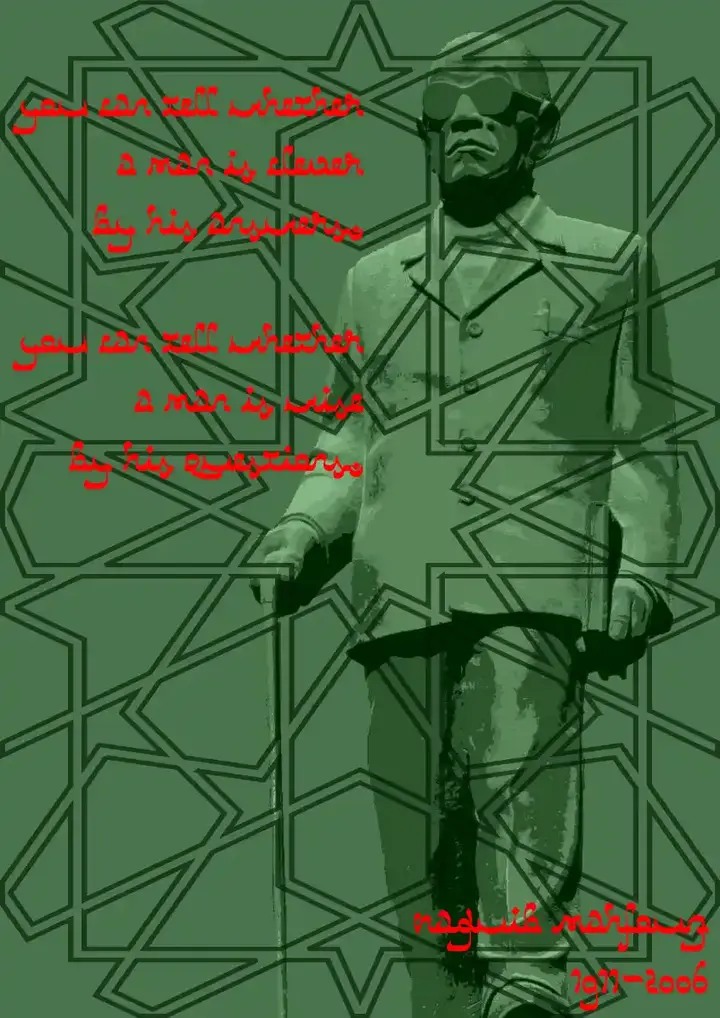Naguib Mahfouz: The Giant of Arabic Literature
Naguib Mahfouz stands as a prominent figure in the world literature scene, famous not only for his prolific production, but also for his deep insight into the human condition. As the only Arab writer to receive the Nobel Prize in Literature, Mahfouz's work transcends cultural boundaries, providing a window into the complexities of Egyptian society, and tackling global themes that resonate with readers around the world. This article examines Naguib Mahfouz's life, works, and lasting legacy, and explores the reasons behind his unique influence on literature.
Show key points
- Naguib Mahfouz, the only Arab recipient of the Nobel Prize in Literature, is celebrated for his rich portrayal of the human condition and Egyptian society.
- Growing up in a culturally vibrant Cairo and studying philosophy at Cairo University shaped Mahfouz’s worldview and influenced his literary orientation.
- Mahfouz’s literary journey evolved from historical realism to psychological realism, symbolism, and later, experimental forms involving Sufi themes and dreams.
- ADVERTISEMENT
- His masterwork, the Cairo Trilogy, earned him international acclaim for its intricate depiction of one family's life amidst Egypt’s political and social transformations.
- Deeply committed to literary integrity, Mahfouz courageously addressed themes such as authoritarianism, social injustice, and moral complexity in his works.
- His clear, symbolic, and accessible prose style shares affinities with global literary giants like Hemingway, Dostoevsky, García Márquez, and Achebe.
- Mahfouz’s legacy resonates across cultures, inspiring generations of writers and affirming literature's ability to bridge diverse human experiences.
Early life and influences

Born on December 11, 1911 in Cairo, Egypt, Naguib Mahfouz Abdel Aziz Ahmed El Basha grew up in a culturally rich environment that influenced his perception of the world and his literary orientation. His father, Abd al-Aziz Ibrahim, was a civil servant, and his mother, Fatima Mustafa Qushisha, daughter of Sheikh Mustafa Qushisha, an al-Azhar scholar, came from a prominent family engaged in trade. Naguib Mahfouz was the youngest of his brothers, and the difference between him and his closest siblings was ten years, so he was treated like an only child. When the 1919 revolution took place, Mahfouz was 7 years old, and his upbringing contributed to his acquaintance with the diverse fabric of Egyptian society, providing him with a deep understanding of its social dynamics, traditions and tensions, which he later remembered in the novel Between the Two Palaces, the first part of his trilogy.
Recommend
Mahfouz joined Cairo University in 1930, obtained a bachelor's degree in philosophy, and then proceeded to prepare a master's thesis on beauty in Islamic philosophy, then changed his mind, and decided to focus on world literature. Mahfouz's early education at the prestigious Egyptian University contributed to his exposure to Western literature, philosophy, and political thought, which influenced his intellectual development. He was particularly attracted to the works of European novelists such as Charles Dickens, Gustave Flaubert, and Fyodor Dostoevsky, whose novels explored the complexities of human nature and society.
During the period of cessation of writing after the 1952 revolution, Naguib Mahfouz married Sayyida Attiyatullah Ibrahim, but invoked his interest in caring for his mother, his sister's family and her children, and hid the news of the marriage from his surroundings during a period of ten years. During this period, his income from writing work, especially film scripts, improved, and his financial situation enabled him to sponsor a family. His marriage remained under wraps during all that period until a fight occurred at school between one of his daughters, um Kulthum, and a classmate, and the student's father, the poet Salah Jaheen, told the matter, which contributed to the spread of the news among acquaintances.
Naguib Mahfouz held a number of positions, most notably as secretary in the Ministry of Awqaf (1938-1945), director of the Al-Qard Al-Hassan Foundation in this ministry until 1954, director of the office of the Minister of Guidance, director of censorship of artistic works in the Ministry of Culture, director general of the Cinema Support Corporation in 1960, and advisor to the General Organization for Cinema, Radio and Television. His last government position was Chairman of the Board of Directors of the General Organization for Cinema (1966-1971), after which he retired to become one of the writers of the Al-Ahram Foundation.
Naguib Mahfouz's literary career and his main works

Mahfouz began his literary career in the mid-thirties when he was a student, and he used to publish his short stories in Al-Resala magazine. In 1939, he published his first novel, The Absurdity of Fates, which was characterized by the concept of historical realism. He then published the struggle of Thebes, and Radobes, and in doing so, ended a historical trilogy in the time of the pharaohs. In 1945, Naguib Mahfouz began his realist narrative line, and maintained it for most of his literary career with the novels New Cairo, Khan al-Khalili, and Al-Madaq Alley. After that, Naguib Mahfouz turned towards psychological realism in the novel The Mirage, and then returned to social realism with the novels The Beginning and the End, and the Cairo Trilogy. After this category, Mahfouz turned to symbolism in novels such as The Beggar and Children of Our Neighborhood. This account led to strong reactions and incitement to an assassination attempt. At an advanced stage of his literary career, Mahfouz adopted new concepts such as fantasy writing, which appeared in novels such as The Harafish and The Nights of the Thousand Nights. He also wrote in Sufi revelations, dreams, and this was represented in the echoes of autobiography, and dreams of the recovery period, where poetic condensation appears, and the explosion of language. Mahfouz's writings serve as a mirror of social and political life in Egypt on the one hand, and a contemporary codification of the concerns of human existence and the human condition on the other. These works reflect the vision of intellectuals of different tendencies to power. Mahfouz's early works translated the social and political turmoil in Egyptian society and expressed his deep concern for the plight of the common people. With the publication of the Cairo trilogy – which includes "The Palace Walk" (1956), "The Palace of Desire" (1957), and "Sugar Street" (1957) – Mahfouz achieved international fame and established himself as a storyteller master.
The Cairo trilogy recounts the life of the Abdel-Gawad family in the context of Egypt's turbulent transition from colonial rule to independence. Through the complex depiction of family relationships, social customs and political turmoil, Mahfouz captures the essence of Egyptian society, delving into global themes of love, betrayal and redemption.
In addition to the Cairo Trilogy, Mahfouz's work includes numerous novels, short stories, and essays exploring a wide range of topics, from existential anxiety and religious philosophy to the nature of power and power. Notable works include The Thief and the Dogs (1961), Children of the Neighborhood (1959) and Ibn Fattouma's Journey (1983). These works cemented Mahfouz's reputation as one of the world's most diverse and visionary writers of the twentieth century.
Literary style and themes

Mahfouz's literary style is characterized by simplicity, clarity and attention to detail. His prose is characterized by a lyrical nature that embodies the rhythm of everyday speech, making his works accessible to readers despite cultural and linguistic divisions. Moreover, Mahfouz's use of symbolism, metaphor, and irony enriches his novels, inviting readers to reflect on the deeper layers of meaning beneath the surface. Mahfouz, like Ernest Hemingway, used a style that was simple and clear. Both writers avoid ornate language in favor of direct prose that allows the narrative to shine. This simple approach not only enhances readability, but also imparts a sense of immediacy and authenticity to their work. Whether depicting the bustling streets of Cairo or the quiet exploration of the character, preserved prose, like Hemingway, is characterized by economy of expression and precision of detail.
Objectively, Mahfouz's work is imbued with a deep sense of humanity, reflecting his belief in the inherent dignity and worth of each individual. It explores the complexities of human relationships, the struggle for identity and self-realization, and the constant pursuit of meaning and fulfillment in a rapidly changing world. Moreover, Mahfouz's engagement in existential and philosophical questions reflects his deep reflection and intellectual curiosity, inviting readers to confront the fundamental questions of existence. In terms of delving into the complexities of humanistic psychology, Mahfouz is similar to Fyodor Dostoevsky. Like the Russian professor, Mahfouz excels at portraying the inner lives of his characters, exploring with deep insight and empathy their hopes, fears, and moral dilemmas. Whether grappling with existential anxiety, moral ambiguity, or the consequences of individual choices, both explore the depths of the human psyche and reveal the universal truths that bind us all.
A reserved use of symbolism and metaphor invites comparison with Gabriel García Márquez. Like the Colombian master of magical realism, Mahfouz instills in his novels symbolic images and metaphorical elements that give his stories deeper layers of meaning. Whether it is exploring the cyclical nature of history, the clash between tradition and modernity, or the mysteries of human consciousness, both writers blur the boundaries between reality and fiction, and invite readers to reflect on the metaphysical and existential dimensions of existence.
In balancing cultural specificity with global themes, Mahfouz shares similarities with Chinua Achebe. Both authors draw on their respective cultural backgrounds to create plot-rich narratives that resonate with readers from diverse cultural and linguistic backgrounds. While Mahfouz's work is steeped in the sights, sounds and smells of Cairo, Achebe's novels evoke Nigerian landscapes and traditions. Underneath these superficial differences, however, lies a shared commitment to explore global themes such as power, identity, and colonialism, emphasizing the interconnectedness of the human experience across borders and continents.
In short, Naguib Mahfouz's literary style reflects the resonances of many international writers, reflecting his unique cultural perspective and the global themes that drive his work. From the simplicity and clarity of his prose to his exploration of psychological depth, social realism, symbolism, and metaphor, Mahfouz's works transcend national boundaries and invite readers to deal with the timeless questions of human existence.
Social and political opinion

As a careful observer of Egyptian society, Mahfouz did not shy away from addressing the pressing social and political issues of his time. All of his works include sharp criticisms of authoritarianism, corruption and social injustice, while defending the cause of individual freedom and human rights. Moreover, Mahfouz's exploration of religion, especially Islam, reflects his nuanced understanding of its role in shaping Egyptian identity and culture.
Despite being censored and persecuted by the authorities, Mahfouz remained steadfast in his commitment to artistic integrity and freedom of expression. His unwavering courage and moral clarity have won him the admiration of readers and fellow writers alike, making him the voice of conscience in a turbulent world.
Legacy and influence: Mahfouz's legacy extends far beyond Egypt's borders, transcending cultural, linguistic, and ideological divisions. His works have been translated into many languages and continue to resonate with readers around the world, attesting to their enduring importance and universality. Moreover, Mahfouz's status as the only Arab writer to receive the Nobel Prize in Literature raised his status as a literary giant, and strengthened his position in the world literature complex.
Mahfouz's influence can be seen in the work of later generations of Arab writers, who were inspired by his literary achievements and commitment to artistic excellence. Moreover, his exploration of themes such as identity, exile, and the clash of civilizations continues to enrich contemporary debates about the Arab world and its place in the global community.

In conclusion, Naguib Mahfouz's contributions to world literature are invaluable, encompassing a wide range of works that reflect the richness and complexity of the human experience. Through his insightful depiction of Egyptian society, his exploration of global themes, and his unwavering commitment to artistic integrity, Mahfouz left an indelible imprint on the literary scene of the twentieth century and beyond. As readers continue to engage with his work, they are reminded of literature's enduring power to transcend borders, bridge gaps, and shed light on the common humanity that binds us all.
Although Naguib Mahfouz's literary style is deeply rooted in his Egyptian heritage and cultural context, it can be compared to many international writers, classical and contemporary. His style of storytelling, the use of language and objective exploration show similarities to writers from different traditions, demonstrating the universality of its themes and the timeless appeal of its prose.








